NICU families get a jump on healing with skin-to-skin “kangaroo” care
Summary:
Why early skin-to-skin contact is a win-win for caregivers and their babies
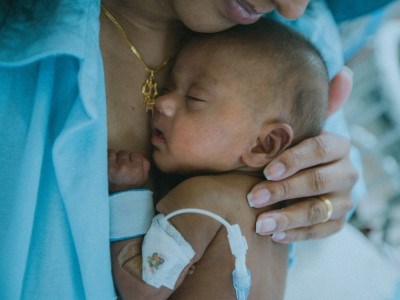
In the Neonatal Intensive Care Unit (NICU) at The Hospital for Sick Children (SickKids), skin-to-skin contact is considered some of the best medicine for babies and parents.
Although it’s often called kangaroo care because of the bundling of the baby against a parent’s chest, the nurturing touch shared between the two can also be experienced in other ways.
“Our NICU families can be understandably nervous about holding skin-to-skin,” says Kim Dionne, a Nurse Practitioner in the NICU. “The babies are fragile, and the caregivers need to know skin-to-skin can be done safely and that it’s beneficial for the baby and them. They just need that extra reassurance once the baby is out of the incubator.”
While some critically ill babies are not ready to be transferred from their incubators, families can still provide a nurturing touch to their babies in the NICU through such techniques as finger-holding and hand-hugging. Once the care team gives the okay, families are strongly encouraged to hold their babies skin-to-skin.
The percentage of caregivers holding skin-to-skin has increased thanks to the efforts and expertise of the NICU team. There is new signage about the benefits placed throughout the unit as well as rounding by health teams to promote skin-to-skin to help caregivers overcome any barriers. More recently, SickKids also took part in an educational campaign along with two other Toronto NICUs to promote awareness and encourage families to hold babies skin-to-skin for longer periods of time.
Kim adds that skin-to-skin is considered a therapeutic intervention for many reasons that are good for caregivers and their newborns:
- Easier breastfeeding and increased breast milk production
- Regulates baby’s body temperature
- Lowers parental anxiety and depression
- Improves heart and respiratory rate, and quality of sleep
- Early bonding and connection
SickKids has a protocol to identify babies who are ready for skin-to-skin care. Every week a team comprised of many disciplines including a neonatologist, quality leader, nurse practitioner, nurse educator, occupational therapist, lactation consultant, family/parent liaison, respiratory therapist and bedside nurse promotes its value during face-to-face conversations with families.
Here are the stories of two babies and their families who came to SickKids unexpectedly and found hope and healing through skin-to-skin care.
Baby Kaaviya
The parents of baby Kaaviya, Anitha and Shiyamalan, weren’t expecting their baby to be born at 22 weeks “on the dot.” Kaaviya only weighed 460 grams at birth.
An infection required surgery about a week later, which brought them to SickKids. “We were crying and sobbing because we didn’t know what to expect and if she was going to make it,” Anitha says. “She was a little warrior who came through.”
After four traumatizing weeks the couple received the all-clear to hold their baby, but they resisted at first. They preferred “hand-hugging” to avoid moving Kaaviya and risk doing anything that would adversely affect her progress.
“I remember with my brother’s baby I was very apprehensive about holding,” says Shiyamalan. “I always prefer to wait to hold babies until they are stronger.”
That all changed on March 13, 2025, which was exactly one month to the day that Kaaviya was born.
“It’s a lot of work for the staff to have us hold her, and it was nerve-wracking and intimidating to take her on my chest at first, but when I did it was a really good feeling,” Anitha says. “Once she was on me I settled in and went from sobbing every day to knowing that she’s good and doing well.”
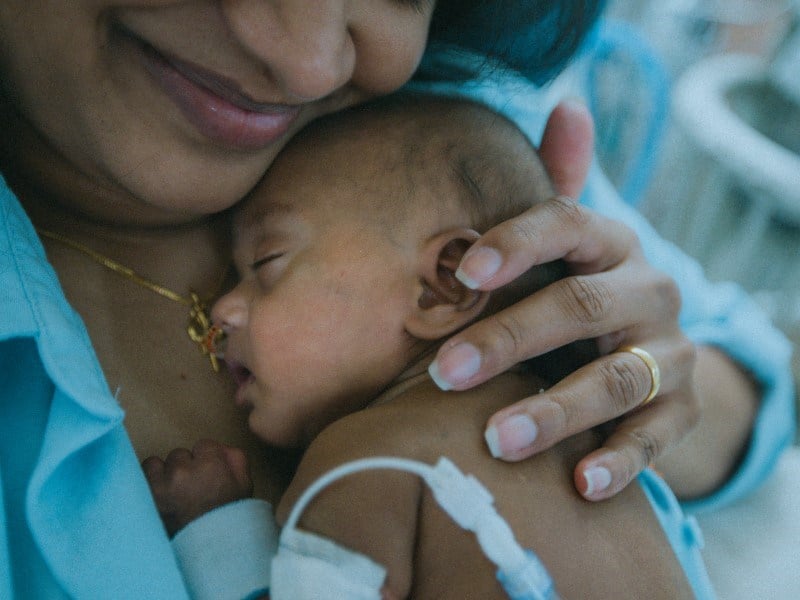
She was told that with skin-to-skin, you can feel the baby’s heartbeat start off fast and steadily slow down to match your own, and that’s exactly what it felt like for her.
Anitha, who was a SickKids patient herself from the age of five to 18, is grateful for all the support from SickKids staff “in every way possible.” Without their encouragement and support they may not have given skin-to-skin a try.
Now that they’re through the difficult early days, their advice to other families is to look inward for positivity by having faith in your baby, yourself, and thinking good thoughts.
“When I’m holding her for hours each day, I talk to her a lot and tell her the same three things I’ve been saying since the day she was born,” Anitha says. “’You’re strong, you’re beautiful and you’re healthy.’”
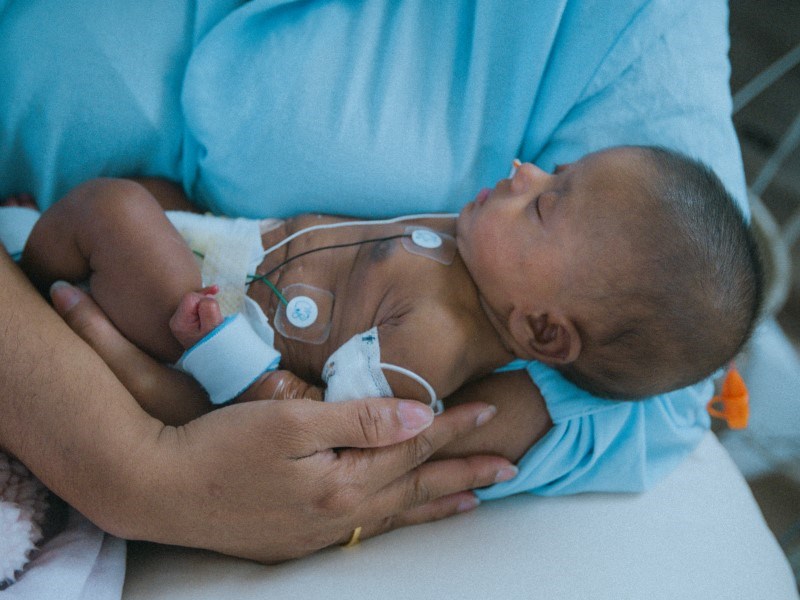
Baby Ocean
The parents of baby Ocean, Diamond, Kevina and Kyle, went to their local hospital in Bermuda when Diamond experienced an early water break. Because she had only reached a little more than 23 weeks’ gestation, the island hospital wasn’t equipped to help at this early stage of the pregnancy.
Their doctor referred their case to SickKids’ International Patient Program (IPP) and they were accepted. After 36 hours they were transported to Toronto by a group they described as “medical Avengers.”
Diamond delivered Ocean a couple of days later through an emergency C-section, and everything was fine for the first week. Then, on Mother’s Day, they were told that there was another complication and Ocean needed emergency surgery at SickKids.
After surgery and amid a steady stream of well-meaning Mother’s Day messages, Ocean was struggling to survive. “She wasn’t expected to make it through the night, so I asked to hold her,” Diamond says. “They let us hold her on a big bed of blankets and I think it was good for her and us.”
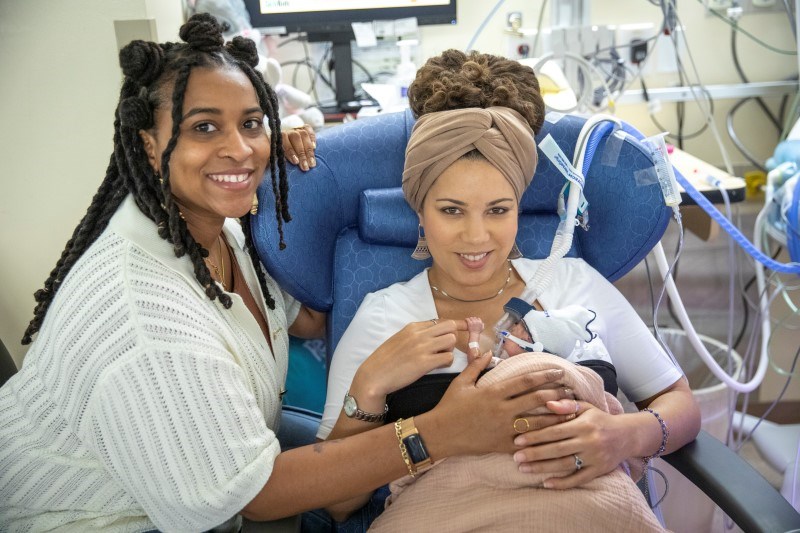
The thought that this could be their baby’s last night was unbearable, but they were determined to celebrate her life and “be her moms.”
“We sucked back our tears and refused to mourn her while she’s here,” Kevina says. “We held her, read books and sang – her song is ‘Ocean Eyes’ by Billie Eilish – told her about her house, bedroom, and the friends and family at home who love her.”
Ocean made it through the night, and the next night, and all the nights after that.
With Diamond’s birthday fast approaching, Kevina asked the care team about holding skin-to-skin. They acknowledged being beyond nervous at first, but they were determined and had the support of their health team.
“It took about seven people, but they made it happen,” Diamond says. “Everyone was so great. It was the best birthday gift ever.”
Before, when all they could do was stare at their tiny baby in a “big box,” they said they didn’t feel like parents. Now that they have seen – and felt – the benefits of skin-to-skin for themselves, they do it for hours on end.
“There was a disconnect when we couldn’t hold her and skin-to-skin closes that gap,” Kevina says.
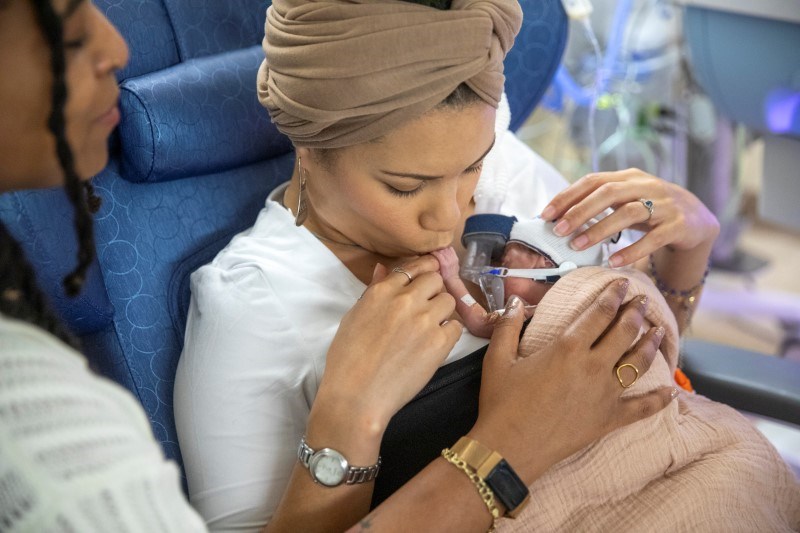
Nothing is more satisfying for the NICU staff than to hear stories about families who overcame their fears about skin-to-skin and do it again and again once they’ve tried it.
Over the past year, SickKids has seen the number of eligible families who engage in skin-to-skin double, and they hope to keep the momentum going through continued education and face-to-face conversations.
“We’ve seen how skin-to-skin can make a difference in the lives of our youngest patients and their families, and as a team we will continue to encourage it whenever possible,” says Lesley Saliwonchyk, NICU Family/Parent Liaison. “Seeing patients and families leave the hospital in a better place than when they arrived, because they practiced our family-centered care philosophy, including skin-to-skin, is what it’s all about.”

For more information, check out this article about skin-to-skin care for hospitalized babies by AboutKidsHealth.

